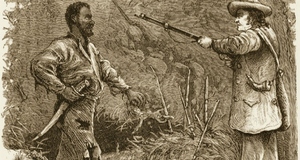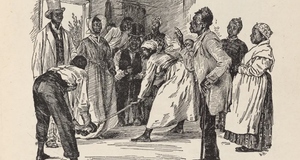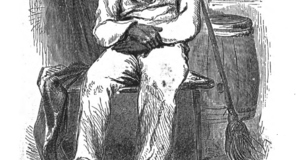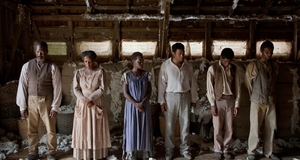Featured Article:The Uprisings of Nat Turner and John Brown: Response and Treatment from the Abolitionist Movement and the PressA Horrible FerocityNat Turner was born in Southampton County, Virginia, on October 2, 1800, the property of Benjamin Turner. Thirty-one years later, he died on a scaffold outside Jerusalem, Virginia. His lifeless body was flayed, beheaded, and quartered. He received no burial, and his headless remains were either buried unmarked or burned. No eulogies were given in his name. His rebellion, sometimes referred to as the Southampton Insurrection, took place in the summer of 1831. Led by Turner, the rebel slaves killed roughly sixty white people--- the highest number of fatalities caused by a slave insurrection in the history of the United States.33 In the aftermath of the rebellion, speculation throughout the South centered on whether the Southampton Insurrection was merely a prelude to a more widespread slave uprising. On that same vein, the Southern press at the time was very keen on finding out any encouragement, or outright assistance that may have been given by anti-slavery elements outside the South. Early reports from major Southern newspapers show an interesting ambivalence: There is great insistence that the insurrection had been quickly and completely vanquished, and that “perfect tranquility has been restored”; on the other hand, readers are constantly reminded that the danger continues--- and that militant readiness must be sustained.34 These prevalent claims to the lasting need of armed vigilance throughout the summer of 1831, perpetuated by newspapers across the entirety of the South, had little basis in fact. Indeed, there is no evidence whatsoever of a planned slave uprising beyond that of the Southampton Insurrection. However, this editorial guesswork dynamited an ever-rising frenzy within the public, and this dynamic eventually led to the murder of around two-hundred black people throughout Southampton and its neighboring counties, as well as the incarceration of many more.35The initial impression given by the Southern press was that it was not slaves who had attacked Southampton County, but rather runaway fugitives whose only intention was to plunder and steal.36 However, in the days following the violence, it became clear that the revolt had been carried out by a handful of local slaves, only a couple of whom were free men.37 Following these revelations, it became increasingly hard for Southern newspapers to declare the revolt as nothing more than the work of run-of-the-mill criminals. Indeed, it soon became evident that the attackers had not been much interested in looting: While the homes of those killed were indeed ransacked, only a marginal amount of money and valuables were taken. By and large, the vast majority of what was taken were simply the necessary things to support the rebellion: Horses, weapons, and ammunition.38 In fact, no buildings were arsoned and, as far as any records indicate, none of the female victims of the insurrection were sexually assaulted.39 The week that immediately followed the Southampton Insurrection was marked by an intense feeling of disarray. Nobody quite knew what had happened, or who had taken part in the revolt. The first mention of a possible ringleader did not come until August 26th, five days after the rebellion took place, when The Petersburg Intelligencer published a letter dated August 24th, in which the correspondent mentions that the “leader was shot in an attempt to force the bridge at Jerusalem.”40 Three days later, on August 29th, more details had begun to surface regarding the mysterious leader of the slave insurrection: The American Beacon published an article in which they claim that “the insurgents…had all been killed or taken prisoner…(the leader) Ned, a preacher or prophet, has been taken.”41 The very next day, The Richmond Enquirer published the first true profile of Nat Turner, who would later be confirmed as the leader of the insurrection. The article asserts that Turner was “a fanatic preacher…who had been taught to read and write, and permitted to go about preaching in the country…He was artful, impudent and vindictive, without any cause or provocation…(Turner), who calls himself General, pretends to a Baptist preacher…(and) declares to his comrades that he is commissioned by Jesus Christ.”42 This article is also the first to maintain that Turner was not among the slaves captured, and declares that “the story of his having been killed at the bridge…is ungrounded.”43 Furthermore, the article offers a truly scathing commentary on the insurrection: “What strikes us as the most remarkable thing in this matter is the horrible ferocity of these monsters. They remind one of a parcel of blood-thirsty wolves rushing down from the Alps; or rather like a former incursion of the Indians upon the white settlements. Nothing is spared; neither age nor sex is respected--- the helplessness of women and children pleads in vain for mercy.”44 The article then goes on to underscore the necessity for one of the laws that will become an immediate effect of the insurrection: “No black man ought to be permitted to turn a Preacher through the country.”45 Perhaps the most interesting press coverage of the Southampton Insurrection is that of John Hampden Pleasants, of the Richmond-based Constitutional Whig. Pleasants was a member of a mounted militia unit in Richmond, and is thus far the only newspaperman known to have travelled to the scene of the event. His coverage began on the very day that the slave uprising was suppressed, calling the insurrection a “disagreeable rumor,” and asserting that “serious danger, of course, there is none… the deluded wretches have rushed on assured destruction.”46 As more information became known in the week following the uprising, Pleasants was able to use his privileged position as the only man at the scene to his advantage. On August 29th, the Constitutional Whig became the first newspaper in the country to publish a list of names of every man, woman, and child who had been murdered by Turner’s men.47 The tone adopted by Pleasants in his articles appears to be much more balanced than would be expected of a Southern man at the time. While he clearly condemns the revolted slaves on the grounds of their violent actions, he mostly refrains from overt racist rhetoric. Moreover, he appears at times to engage himself in a philosophical argument regarding the local reaction and the root of the insurrection itself. When he witnesses a mob of enraged Virginians murder two apparently innocent Blacks, Pleasants writes:
In the same article, he asserts his belief that there was no ulterior motive to the violence of the rebels, and that they acted “under the influence of their leader Nat, a preacher and a prophet among them…even he had no ulterior motive, but...was perhaps misled by some hallucination of his imagined spirit of prophecy.”49 Pleasants engages in a line of reasoning that goes as far as to appear understanding, perhaps even absolving, of the slaves who had been influenced by Turner: “Committing the first murder, finding themselves already beyond the reach of pardon, drunk and desperate, they proceeded in a blind fury, to murder and destroy all before them.”50 Aside from Pleasants’ take on the root of the insurrection and the subsequent violent reaction to it, he appears to have been greatly interested in the effect Nat Turner’s rebellion would have on the citizenry of Virginia, writing the following: “It will be long before the people of this country can get over the horrors of the late scenes, or feel safe in their homes. Many will probably migrate.”51 Likewise, he offers the following opinion regarding Turner’s victims: “It is an aggravation of the crimes perpetrated, that the owners of slaves in this country are distinguished for lenity and humanity. Cotton and corn are the staples here, and the labor of attending to these is trifling compared to what is necessary in other parts of the State.”52 A few days later, on September 3rd, having returned to Richmond, Pleasants wrote a scathing indictment of the Southern press and their coverage of the Southampton Insurrection, which he believed to have had the unforeseen consequence of inciting further violence by the slaves in the area: “We have been astonished…to see the number of false, absurd, and idle rumors…touching the insurrection (in Southampton). Editors seem to have applied themselves to the task of alarming the public mind as much as possible by persuading the slaves to entertain a high opinion of their strength and consequences…the exaggerations to which we have alluded…give the slaves false conceptions of their numbers and capacity, by exhibiting the terror and confusion of the whites, and to induce them to think that practicable.”53 Within the same article, he goes on to once again allude to the great barbarity displayed by whites in the wake of the insurrection, and even offers an apology to the country on behalf of inhabitants of Southampton County, asserting that “we deeply deplore that human nature urged them to such extremities,” while also declaring that “another such insurrection will be signal for the extermination of the whole black population in the quarter of the state where it occurs.”54 Around the time of the Southampton insurrection, newspaper editors were still heavily dependent on first-hand accounts of events that were in places as far out of the way as Southampton County, and majorly relied on letters written by those who we were present at the scene, which were sent through the postal system or by an “express” courier. The other major source was actually other newspapers, which were often smaller, regional newspapers that were closer the scene of the event. Thus, we find that the accounts published by major Virginian newspapers in Richmond and Norfolk in the days immediately following the Southampton Insurrection had already appeared in some form, often verbatim, in small, regional newspapers scattered in the Southampton area.55 This practice also affected the coverage of the Southampton Insurrection in the North, as many newspapers throughout the major cities of the North published accounts of the uprising that they had taken, often word-for-word, from the aforementioned major newspapers of Virginia. This practice, which in modern times would surely constitute plagiarism, greatly contributed to the misinformation that abounded in the weeks that immediately followed Nat Turner’s rebellion. Due to the aforementioned reasons, the early accounts of Turner’s rebellion throughout the entire country are greatly colored by Southern partisanship. However, we cannot discount this early press coverage on the grounds of the sheer lack of credibility contained within the information provided to the public. A note must be made, and a warning is surely needed for modern readers before delving into the content--- but while we must be careful not to take these early reports at face value, they are indeed invaluable when confronting the matter of Southern racism and its role in the way that newspaper coverage unfolded. not only within the South, but also throughout the North. Across the North, the general tone of the press was one of restrained sympathy for the whites who had been killed by Turner’s insurgents. In fact, even anti-slavery newspapers were rather quick to point out that they were absolutely not in favor of any violent interference in matters of slavery, which at the time was still seen as solely the business of sovereign States. Even William Lloyd Garrison’s The Liberator, perhaps the most blatantly abolitionist newspaper in the country, stressed the Southampton Insurrection as a horrible example of what the institution of slavery must inevitably lead to, and never once suggested that Nat Turner and his men should be eulogized or otherwise turned into martyrs to the cause. One need only take a look at the first article published by The Liberator regarding the insurrection in order to see an example of this; on September 3rd, Garrison wrote the following: “What we have long predicted…has commenced its fulfillment. The first step of the earthquake, which is ultimately to shake down the fabric of oppression, leaving not one stone upon the other, has been made. The first drops of blood, which are but the prelude to a deluge from the gathering clouds, have fallen.”56 On the fulfilled prophecy, Garrison goes on to declare: “The dead bodies of white and black lying just as they were slain, unburied--- the oppressor and the oppressed equal at last in death--- what a spectacle!”57 Other newspapers across the North took a different approach to their coverage of the Southampton Insurrection, and instead of reporting the news that had been so thoroughly covered by John Hampden Pleasants--- whose articles had been heavily reprinted throughout the nation--- chose to forgo news articles in favor of editorials which directly responded to the articles published by major newspapers throughout Virginia. New York’s The Daily Advertiser, for instance, published a searing indictment of Pleasants’ article on the Constitutional Whig that had been published on November 3rd. While the editorial admits that Pleasants was right in admitting that the “butcheries on both sides were dreadful,”58 it takes a clear exception to Pleasants’ claim that another slave insurrection will surely result in the extermination of the entire black population in the area where said insurrection takes place:
The editorial goes on to condemn Pleasants for voicing his aforementioned opinion, on the basis that such an argument could produce further violence by the slaves, as well as by the white population of Southampton County. Indeed, the article goes as far as to claim that Pleasants’ article may have had the unintended effect of promoting the violence which saw up to two hundred blacks summarily executed by white mobs throughout the area . Insofar as to the validity of these claims, there appears to be little basis on fact. By the time Pleasants wrote about the potential consequences of further slave uprisings, mobs of enraged whites throughout Southampton County had already mobilized and murdered scores of blacks. However, there can be little doubt that--- indeed--- Pleasants did little to soothe the spirits of the men who were hell-bent on revenge. A strong argument could thus be made that, by legitimizing the potential consequences of the insurgency, Pleasants had a hand on the very behavior he condemned. Another example of Northern newspapers eschewing hard news coverage of the insurrection in favor of reactionary editorials can be found in The Worcester Spy, a Massachussets-based newspaper with abolitionist views. Published on the same day as the aforementioned editorial by The Daily Advertiser, this article also condemns Pleasants’ quote that “another such insurrection will be signal for the extermination of the whole black population in the quarter of the state where it occurs.”60 The article declares Pleasants’ assertion: “A more blood thirsty idea has never entered into the imagination of the veriest(sic) depot that ever lived,” and goes on to declare that “to give over a whole race of two million human beings to butchery and destruction, and all for the fault of a few misguided and deluded individuals, would be an act of fiend-like enormity without its parallel in the history of modern times.”61 In the two examples provided, both of which react to the same quote by a Southern journalist, we can see the kind of discourse that appealed to Northern abolitionists. We can also see that it was not only the Southern press which was prone to hyperbolic statements. After all, however vile Pleasants’ quote may have been, the many editorials written in response forgo the otherwise balanced and honest coverage that Pleasants provided, and instead focused on his only true journalistic blunder. Moreover--- and this surely warrants mentioning--- Pleasants never advocated for the extermination of blacks in the United States. When viewed in its proper context, it is clear that he is voicing his fear that further slave insurgencies may have the effect of exalting the white mobs that were already mobilizing throughout the Southampton area, resulting in the de facto extermination of all blacks within the area affected by a hypothetical second rebellion. Indeed, Pleasants does not once advocate this kind of action, but rather clearly warns Virginians that a retaliation such as this would result in the scorn of the entire nation.62 In fact, these type of hyperbolic editorials published throughout the North engaged in the same behavior which they themselves condemned: By swaying public opinion within the North with fact-less claims regarding a quote which was taken out of context, they furthered the divide between North and South, which would eventually lead to the Civil War they so strongly predicted--- thus turning political discourse into self-fulfilling prophecy. Nat Turner was certainly no hero, and while his intentions may have been the culmination of the human struggle for freedom in which those held in bondage engaged, he--- and those under his command--- indiscriminately murdered men, women, and children. History has absolved Nat Turner, on the grounds that a man can only take so much degradation before turning to the most primal sentiment known to the human heart: revenge. On the other hand, the reactions of the press are beyond absolution. At a time which may have been ripe for, dare we say it, lawful transition into a different kind of world, those with the power to capture the imaginations of the American public and shape the political debate, chose instead to partake in hyperbole and combative rhetoric which did little but further widen the evolving abyss within the divided nation. Alexis De Tocqueville once said that “nothing but a newspaper can drop the same thought into a thousand minds at the same moment.”63 In the aftermath of the Southampton Insurrection, newspapers on both sides of the Mason-Dixon line chose to drop the wrong thought into the mind of America--- what resulted was a widening rift which would only be filled with blood.Continued on Next Page » Suggested Reading from Inquiries Journal
Inquiries Journal provides undergraduate and graduate students around the world a platform for the wide dissemination of academic work over a range of core disciplines. Representing the work of students from hundreds of institutions around the globe, Inquiries Journal's large database of academic articles is completely free. Learn more | Blog | Submit Latest in History |


















